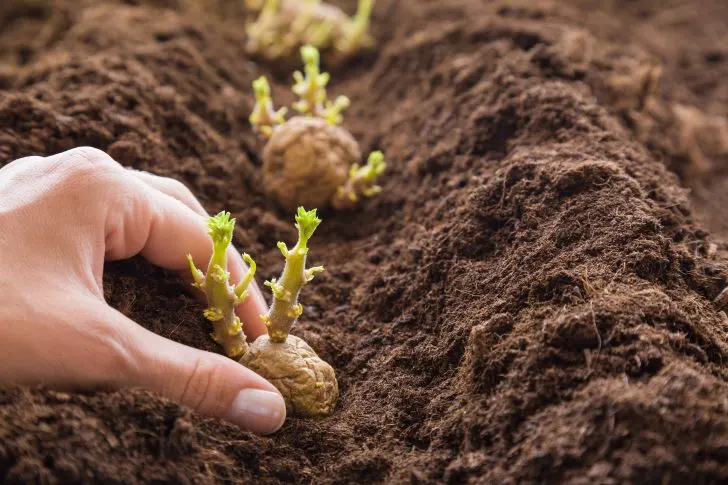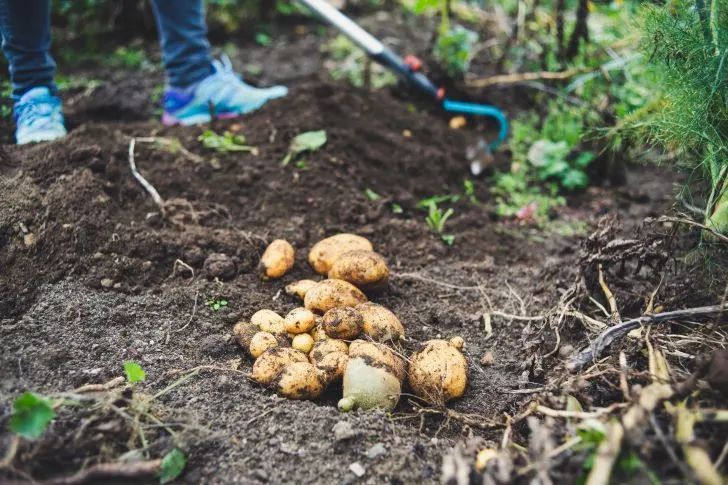Potatoes are one of the most versatile and joyful vegetables.
It’s not only a versatile ingredient of different dishes but also a good source of nutrients with zero cholesterol levels.
Isn’t that impressive?
Regarding all the benefits, many gardeners love to produce a good yield of potatoes in their gardens.
And perhaps you are also one of them.
Right?
If you live in North Carolina and are planning to grow potatoes, the most vital aspect to understand is the best time to plant them.
Today in this blog post, we’ll see when to plant potatoes in NC.
Let’s get started!

When to Plant Potatoes in NC?
North Carolina has a humid, subtropical climate, meaning the region has hot summers and mild to cool winters.
Potatoes love to grow in this type of climate as they can also tolerate slight frost.
But when is the best planting time?
The best time to plant potatoes in NC is March, when the soil temperature ranges between 60 and 70 degrees Fahrenheit.
Pay close attention to your local weather conditions—look for when the last frost occurs.
When you notice that there hasn’t been a frost in the last two weeks, you can plant potatoes in NC.
If planted too early, the tubers wouldn’t produce a sprout, so underground rotting is risky.
- If frost comes after planting tomatoes, you need to take some energetic steps to ensure the healthy growth of your tomatoes.
- If you have initially planted them in the pot, bring them inside. It is easy and more convenient.
- But if you have planted the potatoes in the ground, cover them with a blanket or plastic sheets to protect them from frost.
Well! After discovering the danger of frost, you might consider planting potatoes late.
But I suggest you not to do that if you want a healthy crop. It is because planting the potatoes too late will produce small potatoes or, even worse—almost zero yield.
How to Plant Potatoes in North Carolina?
Growing potatoes in North Carolina can be a rewarding experience for gardeners of all levels.
The state is ideal for cultivating this juicy vegetable with its warm weather and fertile soil.
Let’s explore the intricacies of planting potatoes in NC, allowing you to achieve a bountiful harvest.
Choose the Right Location
When choosing a location for your potato plants, select an area in your garden that receives full sun exposure.
It’s best to avoid planting potatoes in the same area where other nightshade plants like tomatoes and peppers have grown before to prevent soil-borne diseases.
Look for a spot with good drainage sheltered from high winds.
Prepare the Soil
The soil must be well-drained, loose, and of sandy texture because potatoes grow well in fertile and well-drained soil.
Ensure that the pH of the soil is slightly acidic, i.e., between 5.5 to 6.0. The pH plays a vital role in the healthy growth of potatoes.
So, if you don’t know the soil’s acidity, consulting with a soil testing company is better.
Remove any weeds or rocks from the planting area and loosen the soil to a depth of 10–12 inches. Add organic matter such as compost, aged manure, or leaf mold to the soil to improve its fertility and structure.
Cut and Prepare the Seed Potatoes
Select high-quality seed potatoes with healthy sprouts and cut them into pieces so each contains at least one sprout.
Allow them to dry and form a callus for a day or two before planting.
Plant the Potatoes
Dig a 4–6 inches deep trench and place the seed potatoes, cut side down, in the trench with the sprouts facing upwards.
Space the seed potatoes 12–15 inches apart and cover them with 2–3 inches of soil.

Hilling the Potatoes!
Hilling is the practice of mounding soil around the base of a plant, typically used with potatoes.
As the potato plants grow and emerge from the soil, mound soil around the stems to create hills 8–12 inches high.
Hilling is done to protect the tubers from sunlight, which can cause them to turn green and become inedible.
By mounding soil around the base of the plant, the developing tubers are kept covered in the dark.
Also, hilling can help support the plant’s growing stems and roots and improve soil moisture retention.
Water the Potatoes
Water the potatoes consistently, aiming for a consistent soil moisture level.
As the tubers grow and become enlarged, the plant’s water requirements increase. You will likely have a poor yield if you do not provide your plant with sufficient water.
Contrarily too much water can cause the potatoes to rot.
Hence, you should water the potato plant thoroughly once or twice a week.
Fertilize
Potatoes need regular fertilization to thrive.
Thus, it is better to apply a balanced fertilizer, such as 10-10-10, at a rate of one pound per one hundred square feet of planting area two to three weeks after planting and again when the plants are 6–8 inches tall.
Monitor for Pests and Diseases
Potatoes are susceptible to pests and diseases such as:
- Colorado Potato Beetles
- Potato Flea Beetles
- Late Blight
Inspect your plants regularly and take appropriate action if you notice any signs of damage or disease.
In case of any indication, simply remove the infected part and use any natural or synthetic remedies to prevent further damage.
The Ideal Time to Harvest Potatoes!
After dedicating time and effort to planting and nurturing your potato plants, the eagerly anticipated moment arrives to reap the rewards of your labor.
However, the question remains: when is the optimal time for harvesting your potatoes?
After approximately one hundred days from planting, your potato plants will have produced mature tubers ready for harvesting.
You can harvest your potatoes once the tubers have grown to your desired size or when the plants have wilted and died.
For those seeking thicker potato skin, cutting off the wilted plants and leaving the tubers in the soil for another 10 to 14 days before harvesting is recommended.
Here are some tips:
- Before harvesting, allow the soil around the plants to dry out, but not for too long.
- When digging up the potatoes, use a garden fork and be careful not to damage them.
- Once all the potatoes are dug up, brush off any excess soil and inspect them for damage.
- Discarding any potatoes with cuts or bruises is crucial, as they are prone to rotting and unsuitable for long-term storage.
- Even a minor bruise can lead to early spoilage, so take care when digging them up.
- If you accidentally bruise some potatoes during the harvest, it’s best to segregate and use them first to prevent further damage or loss.
- Finally, storing undamaged potatoes in a cool, dry, dark area is essential to maintain their freshness.
Related Post: What To Plant After Potatoes?
That’s all for today!

Now let’s move towards the conclusion.
Conclusion!
Now you don’t need to question when to plant potatoes in NC.
The best time to plant potatoes in North Carolina is in March when the danger of frost has already gone, and the soil temperature is about 60 to 70°F.
After you know the best growing season, you just need to know the best steps to plant potatoes in NC. Although they are simple and easy to grow, if you miss or have done anything wrong, it can affect the overall yield of your potatoes.
I hope you find this post helpful.
If you find this post interesting, don’t forget to share it with your friends.
Regards,
Moiz Atiq.
